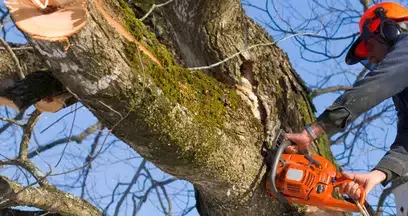 Imagine you've just purchased a beautiful property, complete with a lush, tree-filled landscape. Before you even think about chopping down any of these trees to make way for a pool or a new extension, you'll want to know exactly which species are protected under local law. Violating these laws can land you hefty fines, not to mention the wrath of your eco-conscious neighbors. So, you're probably wondering, 'What trees can't I cut down' Well, you're about to find out, and it might surprise you just how many there are. Understanding Tree Protection Laws While you may be eager to start your landscaping project in Lakeland, it's important to understand the city's tree protection laws to avoid hefty fines and penalties. You've got to know that tree protection laws are pretty strict. They're not just about preserving the city's natural beauty, but also about maintaining a healthy environment. Under these laws, you can't just cut down any tree that's over 5 inches in diameter. You'll need a permit for that. And if you're thinking of removing a tree that's designated as a 'heritage tree', you'd better think twice. You're looking at a more rigorous permitting process, and you mightn't even get the approval. Moreover, you've got to take care of any trees on your property. If you let a protected tree die due to neglect, you could be in for a fine. Protected Tree Species Let's explore the details of the protected tree species to ensure you have a clear understanding of what you're dealing with. Lakeland's regulations safeguard several species. You can't cut down Live Oaks, Southern Magnolias, Bald Cypresses, or Eastern Red Cedars without a permit. These trees are considered heritage trees due to their size, age, or species. Live Oaks are cherished for their broad-spreading crowns and longevity. Southern Magnolias, with their glossy green leaves and large, fragrant white flowers, add beauty and shade. Bald Cypresses, known for their unique, water-loving nature, are vital to local ecosystems. Eastern Red Cedars, with their dense, evergreen foliage, serve as important windbreaks and habitats for wildlife. You need to recognize these species not just by their looks, but by their value to the community. They're not just trees; they're part of its identity. They provide environmental benefits, enhance property values, and contribute to the city's unique character. So, before you decide to cut down any tree, make sure you're well-informed about its species and whether it's protected. You'll be safeguarding the city's natural heritage and avoiding potential fines. Penalties for Unlawful Tree Cutting If you're caught unlawfully cutting down a protected tree, you'll face stiff penalties. The city takes violations of its tree protection laws seriously. Fines, community service, or even jail time are potential consequences for illegal tree removal. The severity of the penalty largely depends on factors like the size, species, and location of the tree. For instance, cutting down a large, rare species in a public park will likely result in a heftier fine than removing a smaller, more common tree from private property. When it comes to fines, you're looking at anywhere from a few hundred to several thousand dollars. Repeat offenders can expect these fines to significantly increase. If you're ordered to do community service, you'll likely spend your time replanting and caring for trees. In extreme cases, you might even face imprisonment. Navigating the Tree Removal Permit Process To avoid penalties, you'll need to understand how to navigate the tree removal permit process in. First, identify if the tree you want to remove is protected. If it's a protected tree, you'll need a permit before any action is taken. Start by downloading the Tree Removal Permit Application from the city website. Fill it out, providing information on the type, size, and location of the tree. Be sure to include the reason for removal. If the tree is diseased or poses a safety risk, you'll need to provide proof. This could be a report from a certified tree service professional or pictures evidencing the issue. Apply along with any supporting documents to the city's Urban Forestry Division. There's a fee for the permit, typically ranging from $25 to $75, depending on the tree's size. Once you've applied, wait for the city's response. It may take up to 10 business days. If approved, you can proceed with the tree removal. If denied, you'll need to appeal the decision or leave the tree standing. Careful navigation of this process ensures compliance with local laws while preserving the lush landscape. Exemptions to Tree Protection Laws While most trees require a removal permit, there are a few exceptions to this rule. You can cut down trees that have fallen due to natural disasters without obtaining a permit. This is to facilitate quick clean-up and recovery efforts. However, you're required to notify the city after the fact. Dead trees are also exempt from permit requirements. You're allowed to cut these down for safety reasons. Still, it's a good idea to consult with a professional tree service professional to confirm the tree's health status before you proceed. The city also makes an exception for fruit trees. You can prune or remove these without a permit, as long as they're on your private property and not within a public right of way. Furthermore, trees that pose an immediate threat to life or property can be removed without a permit. However, you may need to provide proof of the imminent danger if asked by city officials. Conclusion So, you now understand Lakeland's tree protection laws, know which trees are off-limits, and grasp the penalties for unlawful cutting. You've also learned about the permit process and exemptions. Remember, it's not only about adhering to the law but respecting nature. If you're unsure whether a tree is protected, always check first. It's better to be safe than sorry when it comes to preserving its beautiful, natural landscape. Comments are closed.
|
AuthorHawthorne's Tree Service Staff Members Archives
March 2024
Categories
All
|
|
Hawthorne's Tree Service Lakeland FL
Email: [email protected]
Phone: 863-225-4519
Url: https://www.treeservicelakelandfl.com/
cash, check, credit card
500 Florida Ave S #402
Lakeland, FL 33801
 |
|

 RSS Feed
RSS Feed